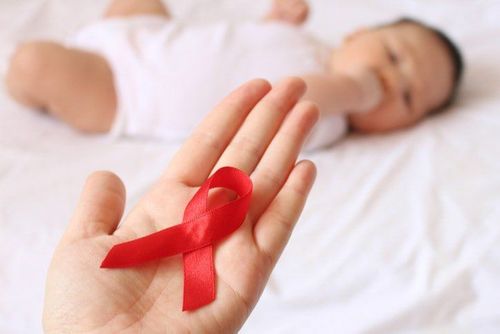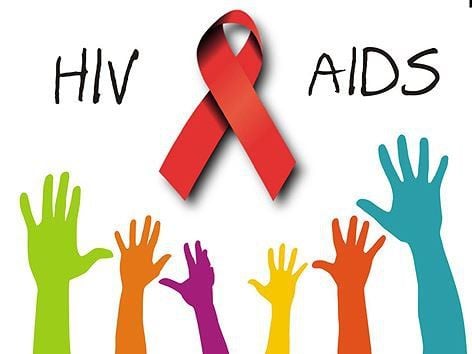This is an automatically translated article.
Pregnancy and childbirth is the mission of every woman. With the development of modern medicine, HIV-infected women still have the right and ability to become mothers if they are actively supported, guided and applied ways to prevent mother-to-child transmission of HIV.
1. What is HIV transmission from mother to child?
Mother-to-child HIV transmission is a term that refers to the transmission of HIV from an infected woman to her baby during pregnancy, childbirth or breastfeeding. This condition is also known as perinatal HIV transmission.
In fact, mother-to-child HIV transmission is completely preventable. There is a lot of evidence that the use of HIV drugs in combination with other strategies reduces the risk of mother-to-child HIV transmission by 1% or less, especially in developed countries such as the United States. and Europe.
In addition, the risk of a pregnant mother with HIV passing it on to her baby is low when the following factors are present:
HIV is detected as early as possible during pregnancy (or before a woman becomes pregnant). Women with HIV are treated with anti-HIV drugs during pregnancy and childbirth and, in certain cases, have scheduled cesarean deliveries. Babies born to HIV-infected mothers receive HIV medication for 4 to 6 weeks after birth and are not breastfed.
At the same time, in order to reduce the rate of children being born with HIV from mother to child, measures to prevent mother-to-child transmission of HIV need to be implemented as soon as possible, right from the prenatal period. before pregnancy) – applies to all women planning to become pregnant in general, regardless of HIV infection, during pregnancy, labor and childbirth. Actions to prevent mother-to-child HIV transmission by stage are outlined below.

Trẻ sơ sinh nhiễm HIV từ người mẹ
2. Prevention of mother-to-child HIV transmission during pregnancy
Every clinic, center, and hospital specializing in obstetrics and gynecology is always recommended to have HIV testing for all women before becoming pregnant or as early as possible in pregnancy. In addition, women should also be retested for HIV in each subsequent pregnancy.
The rationale for this is for the early detection of HIV-infected pregnant women. They will be placed in a management program and given HIV medication. HIV drugs work by preventing the virus from multiplying, reducing the amount of HIV in the body (also called viral load). Having less HIV in the body protects a woman's health and reduces the risk of mother-to-child transmission of HIV during pregnancy and delivery. Even some HIV drugs that are passed from a pregnant woman to her unborn child through the placenta will protect the baby from HIV infection, especially during vaginal delivery and exposure to the virus. bacteria in the mother's blood or other body fluids.
The choice of HIV drug regimen to use during pregnancy depends on a number of factors, including history of current or past antiretroviral drug use, other medical conditions, and outcomes. drug resistance test. Generally, pregnant women with HIV can use the same HIV regimen recommended for non-pregnant adults. If a woman is already on an effective HIV regimen, the same regimen should be continued throughout pregnancy.
3. Prevention of mother-to-child HIV transmission during labor and delivery
Women who have been found to have HIV and are already taking HIV medications still need to continue on their regimen during labor and delivery.
The fetus cannot avoid the risk of exposure to HIV in the mother's blood and secretions during birth. Therefore, continuing to take anti-HIV drugs will keep the viral load in the mother's body at a minimum, minimizing the risk of preventing mother-to-child HIV transmission, especially near delivery.
Thus, a woman who has taken HIV medication during pregnancy should continue to take her HIV medication during labor as scheduled. For women with a high viral load (more than 1,000 copies/mL) or an undetermined viral load, an HIV inhibitor drug called zidovudine is given by intravenous infusion closer to the time of delivery. circuit. Ziovudine passes easily from mother to fetus across the placenta, protecting the baby from any HIV infection that is passed from mother to baby during birth. For this reason, the use of zidovudine during childbirth is considered to have a role in preventing mother-to-child transmission of HIV, even in women with high viral loads near the time of delivery.
In addition, scheduled cesarean delivery may reduce the risk of mother-to-child HIV transmission in women with high viral loads (more than 1,000 copies/mL) or indeterminate viral loads near time. labor point. Accordingly, a cesarean section for this purpose will be scheduled for the 38th week of pregnancy, two weeks before the due date of the last menstrual period.
4. Prevention of mother-to-child HIV transmission in the postpartum period
After childbirth, babies born to HIV-infected women should receive HIV medication as soon as possible to prevent mother-to-child transmission of HIV after birth. It is zidovudine and is indicated for 6 to 12 hours postpartum and for 4 to 6 weeks thereafter. Under certain circumstances, a baby may receive other HIV medicines in addition to zidovudine. At this point, anti-HIV drugs play a role in protecting the baby from getting any HIV that can be passed from mother to baby after birth.
After finishing the 4 to 6 week regimen with zidovudine, the child will be continued with sulfamethoxazole/trimethoprim, which helps prevent Pneumocystis jirovecii pneumonia. This is a type of pneumonia that can develop in people with HIV. After this time, if the HIV test shows that the baby does not have HIV, the child will not need to continue taking the medicine.

Sản phụ và thai nhi sau sinh cần được chăm sóc đặc biệt
In the event that at least two results of two HIV virological tests are positive, the baby is switched from zidovudine to a combination regimen of other HIV medicines. The goal of treatment at this time is not to eliminate the virus from the body, but to stop it from multiplying, helping people with HIV live longer and healthier lives.
In the case of negative results, it is necessary to strictly follow measures to prevent mother-to-child transmission of HIV in the other postpartum period in order to absolutely prevent transmission to the baby. Because HIV can be spread through breast milk, women with HIV are advised not to breastfeed. At this point, infant and baby formula will be seen as a safe and healthy substitute for breast milk. At the same time, there are reports of children becoming infected with HIV by eating food that has been previously chewed by a person with HIV. Accordingly, to be safe, infants and young children should not be given pre-chewed foods.
In addition, the HIV-infected woman herself still needs to continue taking HIV medication after giving birth. Adhering to lifelong HIV medication use will not only prevent HIV from progressing to AIDS for themselves, but also reduce the risk of HIV transmission to those around them, especially in the process of caring for young children, even to the elderly. next pregnancy.
In short, prevention of mother-to-child transmission of HIV should be done for all pregnant women at the first prenatal visit, when it is not known whether HIV infection is present or not. For people who are found to be infected with HIV, taking antiretroviral drugs plays an extremely important role during pregnancy, labor and subsequent breastfeeding, in combination with other measures to limit the possibility of transmission. At the lowest level, let your child have an equal life as other children his age.
Vinmec International General Hospital offers a Package of Examination and Screening for social diseases to help customers detect diseases early and have effective treatment and prevent dangerous complications. The screening package for social diseases at Vinmec is for all ages, both men and women.
To register for examination and treatment at Vinmec International General Hospital, you can contact Vinmec Health System nationwide, or register online HERE.
MORE:
Pregnancy in women with HIV/AIDS: What you need to know about testing and treatment 3 ways of HIV transmission When does an HIV test give the most accurate results?













